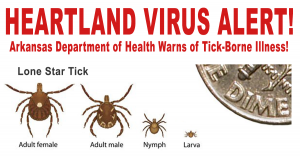Summary
Heartland virus is a viral disease that spreads to people by the bite of an infectious tick. Most patients have symptoms such as feeling tired, fever, headache, lower appetite, nausea, diarrhea, and muscle pain. After developing this disease, patients often have lower counts of white blood cells than a normal person would have. They also have decreased platelets. Although most patients recover after being hospitalized, there are some that do not.
Fact table
| Formal binomial name of microbe: | Virus |
| Gram stain (gram positive, gram negative or neither): | Gram Positive |
| Is the microbe mobile or immobile? | Immobile |
| Primary habitat? (Where is the organism normally found or prefer to live?) | Ticks are typically found outdoors, in wooded or grassy areas, where they attach to their host and begin to feed. |
| Can the organism infect humans? | Yes |
| Can the organism infect other species? If so, which ones. | Ticks can infect dogs, cats, rodents, birds, and deer. |
| Documented cases of antimicrobial resistance? | As of September 2018, more than 40 cases of the Heartland virus disease have been reported from the Midwestern states to the Southern in the United States. |
| Number of infections per year in the US | Two |
| Number of infections per year in the world | Ten |
Symptoms
The Symptoms and signs of Heartland Virus disease are often similar to those of tick borne illnesses. The time from the tick bite to feeling sick is not known yet, however most patients reported the tick bite in the two weeks before they felt sick. All most all patients with Heartland have been hospitalized because of the care and rest they need once they develop the disease. With the help of doctors and care received, most patients do recover from the disease quite well. The patients that do not receive appropriate care or the patients that are already low on white blood cells and are weak unfortunately do not recover from the disease.
Treatment
The treatment for this disease is limited. There are no vaccines or medications to prevent or treat infection with the Heartland virus. Antibiotics do not work either because they are not designed to treat viruses. Healthcare providers might be able to provide medications and other care facilities to help treat the symptoms developed. Most patients do need to be hospitalized for fluids and treatment for pain, fever, or other related problems.
Heartland virus belongs to the genus Phlebovirus which includes viruses that can be transmitted by ticks, mosquitoes, and sandflies. Recent studies have shown that the Lone Star tick is the main organism that transmits the virus. However, it is not known if other species of tick might also be able to transmit it. To prevent the disease one should prevent tick bites. Heartland virus is spread to people by the bite of an infected tick.
Images about the disease


News articles
- Heartland Virus: A New Virus Discovered in Missouri
- In June 2009, two men from Northwestern Missouri were hospitalized with symptoms consisting primarily of fever, fatigue, and diarrhea. Currently, a confirmed case of the Heartland virus disease is defined as a clinically compatible illness in a person which are the symptoms of the disease.
- Heartland Virus Clinical Presentation
- Emerging tick-borne viruses that can infect humans and animals have attracted a lot of attention due to the increasing occurrence of tick viral diseases and their considerable influence on human health. Among these, the Heartland virus was recently identified as a novel tick virus in the United States, and its link to severe human disease with recognizable clinical manifestations was established.
- Tick Borne Heartland Virus Case In Illinois
- The health department says Heartland virus was first identified in 2009 when two Missouri farmers who had been bitten by ticks were admitted to a hospital. Almost all individuals with this virus have been hospitalized. Although most people infected have fully recovered, a few have died. There are no vaccines to prevent Heartland virus infections.
References
“Heartland Virus Disease Symptoms and treatment”; cdc.gov; https://www.cdc.gov/heartland-virus/symptoms-treatment/index.html
“Heartland Virus: A New Virus Discovered in Missouri”; USA.gov; https://www.ncbi.nlm.nih.gov/pmc/articles/PMC6139916/
“Heartland Virus Clinical Presentation”; new-medical.net; https://www.news-medical.net/health/Heartland-Virus-Clinical-Presentation.aspx
“Tick Borne Heartland Virus Case in Illinoi”; kwqc.com; https://www.kwqc.com/content/news/Tickborne-Heartland-Virus-Case-In-Illinois-493960541.html